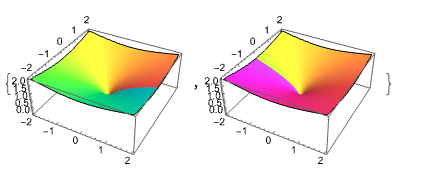First of all, your code in this block:
f[x, y] = (u[x, y] + c) + I v[x, y] // Simplify
eq = Simplify[f[x, y], {x + I*y == z}] /. z -> 0
sol = Solve[eq == 0, c]
f[x, y] = f[x, y] /. sol[[1]]
sets the constant c to -((I Sqrt[x^2 + y^2])/Sqrt[-x + Sqrt[x^2 + y^2]]). I assume this is not the intended effect, and I think it actually makes your answer wrong (or, perhaps, "more wrong".) Your real value of $f$ (assuming, assuming that $c = 0$), should be
u[x, y] = y/Sqrt[-x + Sqrt[x^2 + y^2]];
v[x, y] = (-x + (x^2 + y^2)^(1/2))^(1/2);
f[x_, y_] = (u[x, y] + c) + I v[x, y] // Simplify
f[z_] = f[x, y] /. {x -> 1/2 (z + Conjugate[z]), y -> 1/(2 I) (z - Conjugate[z]), c -> 0}
FullSimplify[f[z]]
(* (I (-z + Abs[z]))/Sqrt[Abs[z] - Re[z]] *)
But this is not actually equal to $\sqrt{2z}$ over the entire complex plane, at least as Mathematica defines the square root function:
Reduce[f[z] == Sqrt[2 z], z]
(* (Re[z] < 0 && Im[z] >= 0) || (Re[z] >= 0 && Im[z] > 0) *)
So, for example, we have
ComplexExpand[{f[-I], Sqrt[-2I]}]
(* {-1 + I, 1 - I} *)
More generally, it appears that in the complement of the region found above, your $f(z)$ is equal to $-\sqrt{2z}$ instead; and everywhere on the plane we have $f(z)^2 = 2 z$:
FullSimplify[f[z]^2]
(* 2 z *)
It'sPlotting out the functions, it also possibleappears that this stems from Mathematica's choice of branch cut for the square rootyour function is equal to (which appears$\sqrt{2z}$ if you define the branch cut to run alonglie on the negativepositive real axis), and that under a different convention for thiswhile Mathematica defines the branch cut your result would agree withto lie on the primary valuenegative real axis:
{ComplexPlot3D[f[z], {z, -2 - 2 I, 2 + 2 I}],
ComplexPlot3D[Sqrt[2 z], {z, -2 - 2 I, 2 + 2 I}]
This kind of the square root function (appropriately defined) everywhere in the complex plane. If I have any inspirations on howambiguity is to do this I'll revisit this answer laterbe expected when dealing with functions with branch cuts.

